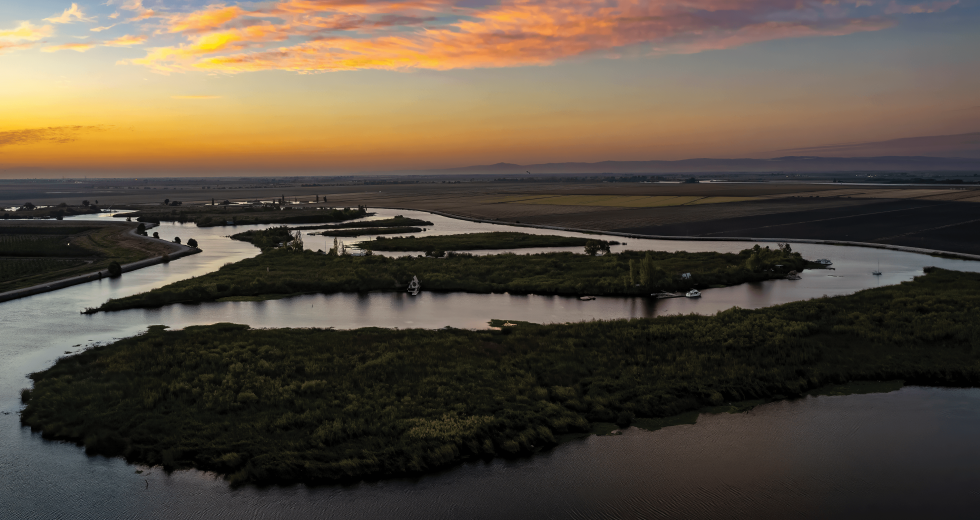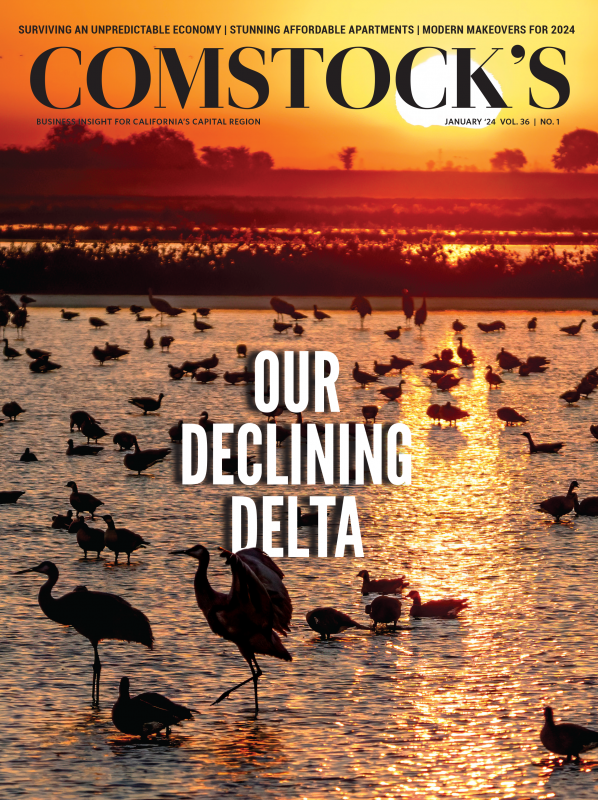The life cycle of a salmon, so the story goes, is a heroic journey. The fish emerge from fertilized eggs in a river bed, swim to the ocean where they spend most of their lives and return to give birth in the exact place where they were born.
The reality in California is more complicated. Many salmon are born in hatcheries — government fish farms. Hatchery salmon are often transported and released near the ocean to avoid the substandard water conditions in the Sacramento-San Joaquin Delta and its tributaries.
The state tries to capture wild juvenile salmon in creeks and bring them to tanks at UC Davis — once again to keep the fish out of the Delta. The salmon that swim the Delta are deterred from one route by a “bio-acoustic fish fence” and then might be caught in a large net if they make a wrong turn towards a pump station, each a measure to keep them alive.
Salmon returning from the ocean face still more obstacles, most notably dams that block them from ancestral breeding grounds.
“As the fish have declined, so have recreation-related businesses: guide services, marinas, bait shops, restaurants, all the things that serve fishing. It has had a huge impact on the economy.”Chris Shutes, executive director, California Sportfishing Protection Alliance
Not enough salmon are completing the journey, and their population numbers have been dropping for decades. Three of four salmon species in California are in critical condition, and the fourth and most common one, Chinook, is at high risk. Half of Chinook salmon types are considered threatened or endangered.
Concern about Chinook salmon and other native fish is driving a plan to improve water quality in the Delta. The Delta doesn’t have enough water, and what it does have is often polluted, too warm for native fish, clogged with invasive species and littered with potentially hazardous algal blooms, according to government reports.
The decline of fish has hurt the Delta’s recreation economy, which is the region’s second-biggest economic sector, trailing only agriculture. Fishing is a big part of that economy, and it influences other kinds of recreational spending, including boat sales and marina rentals.
The water problems are hurting other recreational activities, too, such as swimming.
Direct spending on recreation and payroll for recreational employees accounted for $350 million in annual economic activity in the Delta, according to a 2021 report completed for the Delta Protection Commission, a state agency. That is 16 percent less than what was spent when the same report was done eight years earlier, accounting for inflation. In the intervening years, marinas and other recreational facilities closed and jobs were eliminated.
A pump station near Tracy draws water from the Delta to send
south to cities and farmers. A fish collection facility a couple
of miles upstream tries to prevent fish from getting caught in
the pumps.
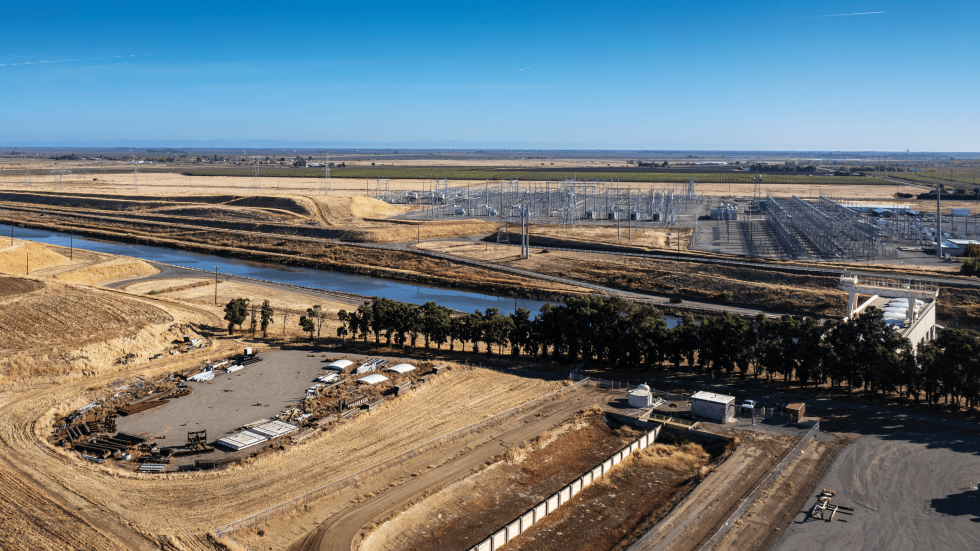
One of the main reasons for the industry’s decline, the report concluded, was substandard water conditions.
“As the fish have declined, so have recreation-related businesses: guide services, marinas, bait shops, restaurants, all the things that serve fishing,” says Chris Shutes, executive director of the California Sportfishing Protection Alliance. “It has had a huge impact on the economy.”
The State Water Resources Control Board is considering a plan to provide more water to the Delta and ease the problems. The focus is on saving fish, but increasing flows is also expected to reduce algal blooms and other water quality issues hurting the recreation industry.
Success is far from guaranteed. Politically powerful groups — farmers and cities — oppose the plan, and Gov. Gavin Newsom is backing their efforts.
The reason for their opposition is simple. The Delta is a huge source of water for cities and growers. They don’t want to give up water.
The Delta runs roughly from Sacramento south to Tracy and from Lodi west to just past Antioch — crisscrossing six counties. It is a 700-mile-long maze of rivers and sloughs surrounding more than 50 islands. The Delta is named after two of the biggest rivers in the state but includes several other rivers.
The state’s two major water development programs, the Central Valley Project and the State Water Project, pump water directly out of the Delta and take water upstream on its tributaries.
Despite its water problems, the Delta remains a sportsperson’s paradise. It provides a range of opportunities for fishers, hunters, bird watchers, boaters, swimmers and other fun-seekers.
Fishing remains a popular activity, although much of it centers on non-native fish like bass that are better suited to the Delta’s altered habitat. Marinas provide storage for boat owners across the Delta.
The Delta lies along the Pacific Flyway, a migration route for hundreds of thousands of birds between South America and the Arctic Circle.
Waterfowl are a big part of the Delta’s recreation economy. Bird watchers and hunters flock to the Delta’s many wildlife refuges. In winter, bird watchers crowd a preserve on Staten Island Road near Galt, home of the largest population of sandhill cranes in California. Nearby Cosumnes River Preserve is another popular spot for bird watching.
Congress recognized these strengths in 2019 when it made the Delta the first National Heritage Area in California. The designation makes the Delta eligible for marketing funds, among other things.
It seems odd, at first blush, that a delta fed by several rivers could have a water shortage. But as California’s population has grown, and its water needs have increased, so has the amount of water taken out of the Delta and its tributaries. The rise of California agriculture into the nation’s leading food producer also played a huge role in the draining of the Delta. Drought has intensified the trend.
Most of the Delta does not have standards for how much water should flow through it, according to the State Water Resources Control Board.
That’s a big problem for fish. “The fish are suffering primarily from a lack of adequate freshwater,” says Jon Rosenfield, science director of San Francisco Baykeeper. “Flow is sort of the master variable that affects almost everything with fish.”
The lack of adequate flow also helps explain some of the Delta’s other water problems, such algal blooms, he says. Algae is always present in the Delta, but the lack of significant flows, particularly in dry years, allows the algae to form into blooms.
Similarly, various types of water pollution would become more diluted and less of a problem with more water flowing through the Delta, Rosenfield says. Staff at the State Water Resources Control Board make similar arguments in support of their draft plan for increasing Delta flows.
In 2022, 60 cases of harmful algal blooms were voluntarily reported in the Delta, according to the Delta Stewardship Council, a state agency. Exposure to the blooms can come through ingestion, skin contact or inhalation and cause seizures, paralysis and other symptoms for people. It can kill animals. One of the hotspots for the outbreaks has been next to Big Breaks Regional Shoreline, a county park in Oakley. Swimming is banned there.
The most recent federal list of polluted water bodies in the Delta showed a 13 percent increase in areas polluted by pesticides or previously polluted areas receiving additional pesticide pollution, according to the council.
Likewise, the federal data showed a 30 percent increase in contaminated areas or previously polluted areas receiving additional contaminants in the Delta, the council reported.
These problems have played varying roles in the decline of Delta fish, according to government reports and experts. Eight types of fish in the Delta are considered threatened or endangered by state or federal authorities, including green sturgeon, steelhead, two varieties of smelt and the four Chinook salmon types. Another nine Delta fish are considered “species of special concern” by state wildlife officials.
The state currently has a ban on salmon fishing and is considering restrictions on other types of fish. A state public health agency recommends that women of childbearing age and children not eat striped bass or green sturgeon from the Delta because of chemical contamination.
The Chinook salmon is at the center of a proposal to increase
water flows in the Sacramento-San Joaquin Delta.
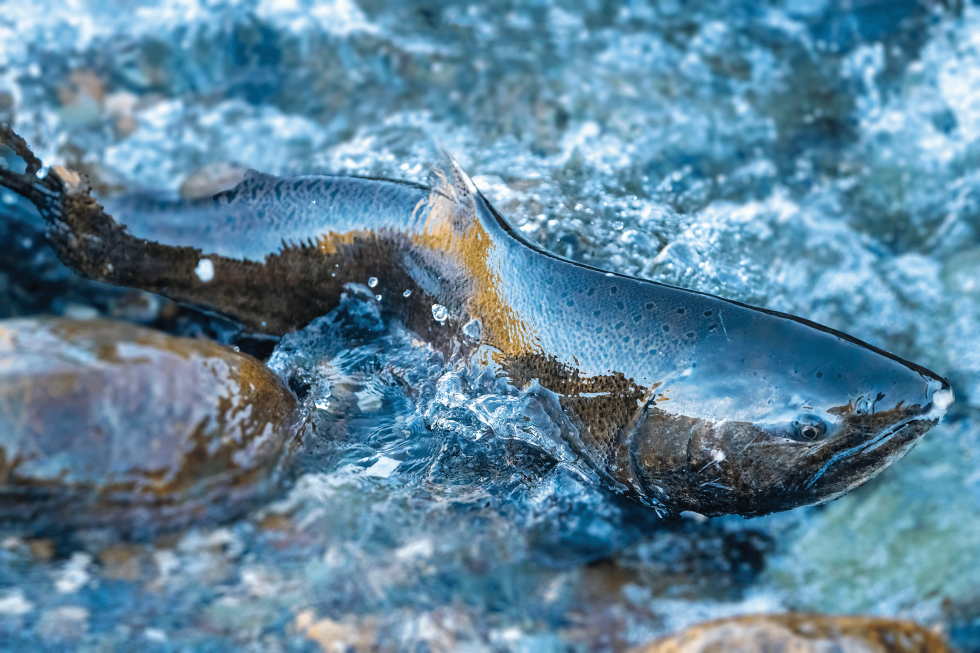
Environmentalists say the Delta is suffering a major ecological collapse. An expert agrees with the characterization.
“They’re absolutely correct,” says Andrew Rypel, director of the Center for Watershed Sciences at UC Davis. “What we are seeing suggests the system is collapsing.”
Chris Lauritzen has watched the changes in the Delta for decades, as owner of Lauritzen Yacht Harbor in Oakley, which had been in the family since 1958, until he recently sold it. He’s 72 and decided it was time to retire.
He can’t recall a new marina being built in the Delta for decades. “If you don’t have fishing, you don’t have boating,” he says. “Fishing is the number one activity for boaters.”
Lauritzen and others also point to the invasion of non-native plants, such as water hyacinth, that have taken over some Delta waterways. “It builds up and is hard to navigate through,” says Shutes of the Sportfishing Protection Alliance.
The number of marinas in the Delta declined from 112 to 97 over a 12-year period ending in 2020, according to the Delta Protection Commission report. The number of recreation and tourism jobs dropped from 3,000 to 2,300 over the same period.
“A lot of decisions made about water could drastically affect the Delta,” says Bruce Blodgett, executive director of the commission. “There is a lack of commitment to these issues in Sacramento.”
The current State Water Resources Control Board proposal addresses flows from the Sacramento River. The board approved a plan for increased Delta flows from the San Joaquin River in 2018, but hasn’t implemented it. Asked why, board staff provided a written statement saying, “the State Water Board is developing a regulation and taking other actions to implement the 2018 Bay-Delta Plan.”
The State Water Board began holding public hearings on the Sacramento River proposal in December. Four of the five board members were appointed by Newsom, while the fifth was appointed by then-Gov. Jerry Brown.
The board is also being asked to consider a counter plan called the “voluntary agreements” submitted by water providers and some other state agencies. Newsom has touted the agreements as a way to avoid the drawn-out legal battles that have become a regular part of the state’s water disputes.
The voluntary agreements do not put a specific numeric threshold on flows to the Delta, like the draft State Board staff plan or the 2018 approved plan. Supporters of the voluntary agreements say they will provide increased flows through a variety of means and make other habitat improvements to help the Delta.
Environmentalists say neither plan does enough, but the staff plan is the only one with a chance of reversing the Delta’s decline.
Stay up to date on business in the Capital Region: Subscribe to the Comstock’s newsletter today.
Recommended For You

What’s Ahead for the Region’s Economy in 2024
Positive news, though risks abound
Those who forecast the direction of the U.S. economy have their eyes on empty office buildings. In September, two commercial real estate experts predicted that the vacant space resulting from work-from-home policies will put banks at risk and collapse tax revenues for large and mid-size cities around the country.
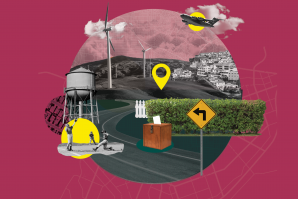
‘Mystery City’ Unveiled
Proposed community envisions the good ol’ days; critics call it sprawl
Sramek, 36, is founder and CEO of California Forever, which seeks to build a large new community in Solano County. While cities or large unincorporated communities have been built from scratch before in California and elsewhere, what makes this potential metropolis unusual — and has stirred public controversy — are the people behind it and its backstory.

The Bosch Boom
Bosch’s acquisition of TSI Semiconductors in Roseville is expected to significantly impact the region’s economy, workforce and educational institutions
In August 2023, Bosch acquired TSI with the intention of producing silicon carbide chips, a major element in the production of electric vehicles. Bosch is betting that the global demand for silicon carbide chips will continue to grow and intends to invest $1.5 billion in the new fabrication.

Give Bees a Chance
Farmers restore habitat for native pollinators
As California grew into a vast agricultural region during the early 20th century, native grasslands, forests and riparian habitats were gradually replaced by farmlands and orchards. Though green things thrive on farms as a matter of business, there’s very little biodiversity on a traditional farm — and not much room for pollen specialists.

Beyond the Bottle
UC Davis is a hub for breast milk science and innovation
As a chemist of food science, J. Bruce German was accustomed to observing the tiniest things: protein particles, bacteria, mucin layers and much more invisible to the naked eye. But nothing prepared him for his first experience in the neonatal intensive care unit at UC Davis.



